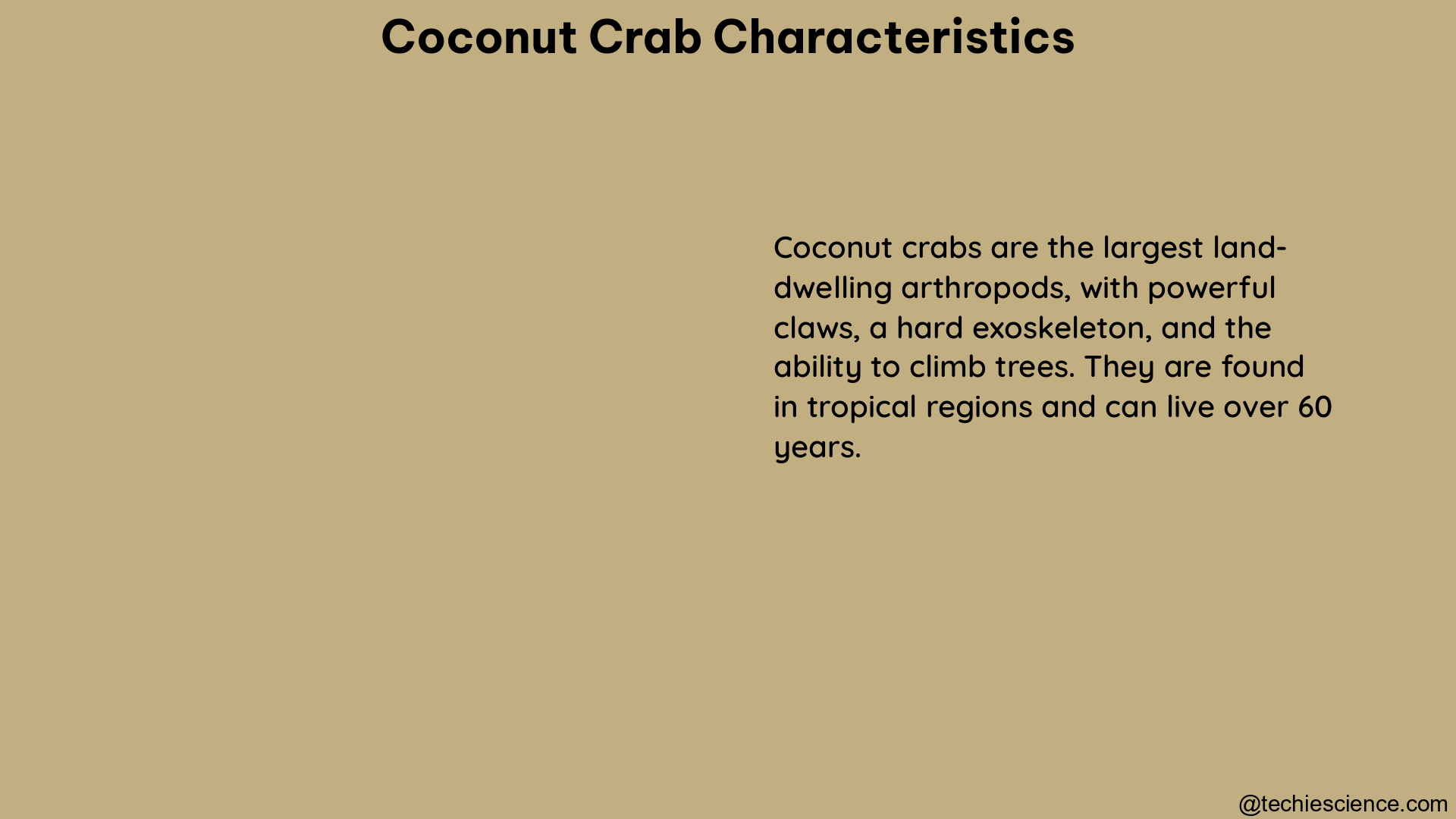Coconut crabs, also known as robber crabs or palm thieves, are the largest terrestrial arthropods, with males reaching up to 75 mm (3 in) in thoracic length and females up to 50 mm (2 in). They can grow to more than 200 mm (8 in) in carapace width and have a leg span of about 800 mm (30 in). These crabs exhibit striking size dimorphism in the adult age class, with males larger than females. They are extremely slow-growing, taking up to 120 years to reach maximum size.
Size and Morphology
- Thoracic Length: Male coconut crabs can reach up to 75 mm (3 in) in thoracic length, while females can grow up to 50 mm (2 in).
- Carapace Width: Coconut crabs can grow to more than 200 mm (8 in) in carapace width.
- Leg Span: These crabs have a leg span of about 800 mm (30 in), making them the largest terrestrial arthropods.
- Size Dimorphism: Coconut crabs exhibit striking size dimorphism in the adult age class, with males being significantly larger than females.
- Growth Rate: Coconut crabs are extremely slow-growing, taking up to 120 years to reach their maximum size.
Coloration and Adaptations

- Color Variation: Coconut crabs have a variable coloration ranging from light violet to blue, deep purple, brown to orange-red, with lighter variegated markings, claws, and leg tips.
- Color Types: Two distinct color types have been identified in coconut crabs: red and blue.
- Claw Strength: Coconut crabs have incredibly strong claws that are used for digging, defense, hunting, and opening coconuts.
- Sense of Smell: Coconut crabs have an excellent sense of smell, similar in structure and ability to insects.
- Temperature Tolerance: These crabs can survive air temperatures up to approximately 37°C (100°F).
Population Dynamics
- Population Density: A CPUE (Catch Per Unit Effort) of one crab per bait corresponds to a population density of 15 crabs per acre. This conversion can only be used for areas of suitable habitat for coconut crabs and for a maximum CPUE of 2.8.
- Size Distribution: The coconut crab population in Mauke displayed a range of sizes, with female crabs having an average size of 30 ± 0.64 mm and males having an average size of 35 ± 0.87 mm.
- Density-CPUE Relationship: Coconut crabs have a strong linear correlation between CPUE (number of crabs per bait) and density (individuals per acre), with an R2 value of 0.81. This relationship is given by the formula: coconut crab density (crabs per acre) = 14.991 × CPUE.
Behavioral Characteristics
- Nocturnal Activity: Coconut crabs are primarily nocturnal, with an average of 47% of captive crabs seen during nighttime censuses and only 12% during daytime censuses.
- Climbing Ability: Coconut crabs are known to climb trees using their strong, pointed legs, although they are more commonly found on the ground or in their burrows.
In summary, coconut crabs are the largest terrestrial arthropods, exhibiting remarkable size dimorphism, coloration, and adaptations. Their population dynamics and behavioral characteristics, such as nocturnal activity and climbing ability, make them unique and fascinating creatures to study.
References:
- Assessment of the coconut crab (Birgus latro) in Mauke, Cook Islands. Link
- Coconut Crab (Birgus latro) Fact Sheet. Link
- BIOLOGICAL STUDIES ON THE COCONUT CRAB (BIRGUS LATRO). Link
- Colour distances of adult coconut crabs plotted against different background. Link
- Morphometric characteristics of coconut crabs (Birgus latro Linnaeus, 1767). Link

Hello, I am Sugaprabha Prasath, a Postgraduate in the field of Microbiology. I am an active member of the Indian association of applied microbiology (IAAM). I have research experience in preclinical (Zebrafish), bacterial enzymology, and nanotechnology. I have published 2 research articles in an International journal and a few more are yet to be published, 2 sequences were submitted to NCBI-GENBANK. I am good at clearly explaining the concepts in biology at both basic and advanced levels. My area of specialization is biotechnology, microbiology, enzymology, molecular biology, and pharmacovigilance. Apart from academics, I love gardening and being with plants and animals.
My LinkedIn profile-